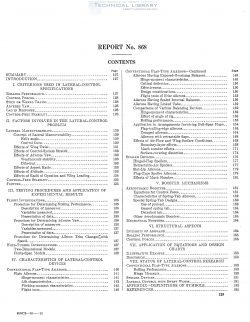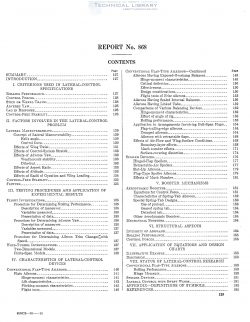naca-report-868

- Version
- 583 Downloads
- 7.08 MB File Size
- 1 File Count
- August 31, 2016 Create Date
- August 31, 2016 Last Updated
National Advisory Committee for Aeronautics, Report - Summary of Lateral Control Research

A summary has been made of the arailable information on
lateral control. A discussion is giren of the criterio’ns used in
lateral-control specifications, of the factors involved in obtaining
satisfactory lateral control, and of the methods employed in
making lateral-control investigations in flight and in wind
tunnels. The arailable data on conrentional flap—type ailerons
having carious types of aerodynamic balance are presented in.
a- form concenient for use in design. The characteristics of
spoiler devices and booster mechanisms are discussed. The
efiects of lfach number, boundary layer, and distortion of the
wing or of the lateral—control system are considered insofar as
the available information perm-its. An example is included to
illustrate the use of the design data. The limitations of the
arailable information and some of the lateral-control problems
that remain to be solved are indicated.
The lateral—control research that had been conducted by
the NACA prior to 1937, and that was summarized in refer—
ence 1. was concerned primarily with the design of lateral-
control devices having suficient effectiveness to enable the
pilot of an airplane to keep the wings level at all normal
flight- speeds. In order to meet that condition large rolling-
moment coefficients are required only at speeds approaching
the stall; consequently, the provision of adequate rolling
performance is principally a problem of the size of the device,
the aerodynamic balance being of only secondary importance
even for moderately large airplanes.
Between 1937 and 1941 a study was made of the lateral-
control characteristics of a large number of combat and non-
combat airplanes. The results of that study, reported in
reference 2, indicated that the provision of lateral control
that is sufficient only to keep the wings level is inadequate,
and that a certain minimum standard of rolling performance
is desirable for any type of airplane, even at high speeds.
Subsequent experience has indicated that combat airplanes
may be required to perform rapid rolling maneuvers near
maximum speed. The problem of providing aerodynamic
balance for light control forces at. high speeds therefore
has become at least as important- as the problem of providing
adequate effectiveness of the lateral—control device.
| File | Action |
|---|---|
| naca-report-868 Summary of Lateral Control Research.pdf | Download |
Comment On This Post